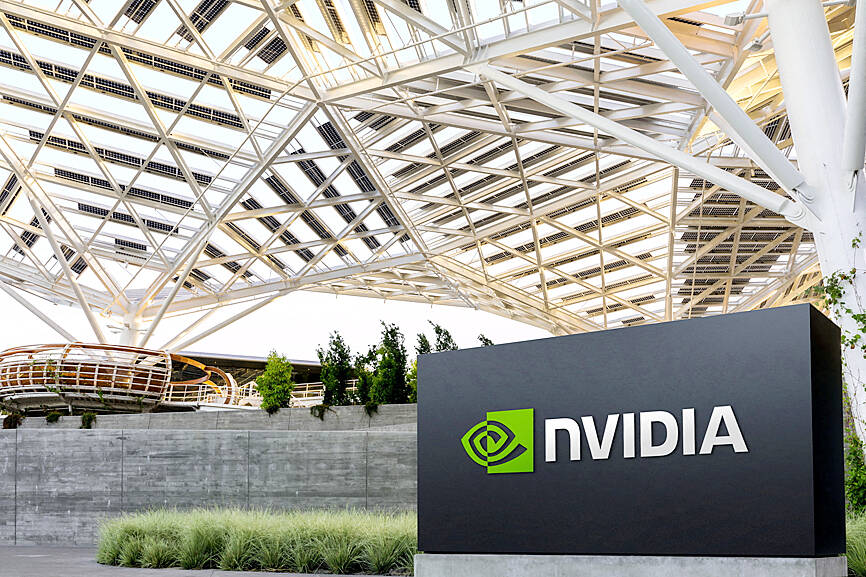Nvidia Corp earned its US$2.2 trillion market cap by producing artificial intelligence (AI) chips that have become the lifeblood powering the new era of generative AI developers from start-ups to Microsoft Corp, OpenAI and Google parent Alphabet Inc.
Almost as important to its hardware is the company’s nearly 20 years’ worth of computer code, which helps make competition with the company nearly impossible. More than 4 million global developers rely on Nvidia’s CUDA software platform to build AI and other apps.
Now a coalition of tech companies that includes Qualcomm Inc, Google and Intel Corp plans to loosen Nvidia’s chokehold by going after the chip giant’s secret weapon: the software that keeps developers tied to Nvidia chips. They are part of an expanding group of financiers and companies hacking away at Nvidia’s dominance in AI.

Photo: Reuters / Nvidia
“We’re actually showing developers how you migrate out from an Nvidia platform,” Qualcomm head of AI and machine learning Vinesh Sukumar said in an interview.
Starting with a piece of technology developed by Intel called OneAPI, the UXL Foundation — a consortium of tech companies — plans to build a suite of software and tools that would be able to power multiple types of AI accelerator chips, executives involved with the group said.
The open-source project aims to make computer code run on any machine, regardless of what chip and hardware powers it.
“It’s about specifically — in the context of machine learning frameworks — how do we create an open ecosystem, and promote productivity and choice in hardware,” Google director and chief technologist of high-performance computing Bill Magro said in an interview.
Google is one of the founding members of UXL and helps determine the technical direction of the project, Magro said.
UXL’s technical steering committee is preparing to nail down technical specifications in the first half of this year. Engineers plan to refine the technical details to a “mature” state by the end of the year, executives said.
These executives stressed the need to build a solid foundation to include contributions from multiple companies that can also be deployed on any chip or hardware.
Beyond the initial companies involved, UXL will court cloud-computing companies such as Amazon.com Inc and Microsoft’s Azure, as well as additional chipmakers.
Since its launch in September last year, UXL has begun to receive technical contributions from third parties that include foundation members and outsiders keen on using the open-source technology, executives said.
Intel’s OneAPI is already usable, and the second step is to create a standard programming model of computing designed for AI.
UXL plans to put its resources toward addressing the most pressing computing problems dominated by a few chipmakers, such as the latest AI apps and high-performance computing applications. Those early plans feed into the organization’s longer-term goal of winning over a critical mass of developers to its platform. UXL eventually aims to support Nvidia hardware and code in the long run.
Asked about the open source and venture-funded software efforts to break Nvidia’s AI dominance, Nvidia executive Ian Buck said in a statement: “The world is getting accelerated. New ideas in accelerated computing are coming from all across the ecosystem, and that will help advance AI and the scope of what accelerated computing can achieve.”

The US dollar was trading at NT$29.7 at 10am today on the Taipei Foreign Exchange, as the New Taiwan dollar gained NT$1.364 from the previous close last week. The NT dollar continued to rise today, after surging 3.07 percent on Friday. After opening at NT$30.91, the NT dollar gained more than NT$1 in just 15 minutes, briefly passing the NT$30 mark. Before the US Department of the Treasury's semi-annual currency report came out, expectations that the NT dollar would keep rising were already building. The NT dollar on Friday closed at NT$31.064, up by NT$0.953 — a 3.07 percent single-day gain. Today,

‘SHORT TERM’: The local currency would likely remain strong in the near term, driven by anticipated US trade pressure, capital inflows and expectations of a US Fed rate cut The US dollar is expected to fall below NT$30 in the near term, as traders anticipate increased pressure from Washington for Taiwan to allow the New Taiwan dollar to appreciate, Cathay United Bank (國泰世華銀行) chief economist Lin Chi-chao (林啟超) said. Following a sharp drop in the greenback against the NT dollar on Friday, Lin told the Central News Agency that the local currency is likely to remain strong in the short term, driven in part by market psychology surrounding anticipated US policy pressure. On Friday, the US dollar fell NT$0.953, or 3.07 percent, closing at NT$31.064 — its lowest level since Jan.

The New Taiwan dollar and Taiwanese stocks surged on signs that trade tensions between the world’s top two economies might start easing and as US tech earnings boosted the outlook of the nation’s semiconductor exports. The NT dollar strengthened as much as 3.8 percent versus the US dollar to 30.815, the biggest intraday gain since January 2011, closing at NT$31.064. The benchmark TAIEX jumped 2.73 percent to outperform the region’s equity gauges. Outlook for global trade improved after China said it is assessing possible trade talks with the US, providing a boost for the nation’s currency and shares. As the NT dollar

The Financial Supervisory Commission (FSC) yesterday met with some of the nation’s largest insurance companies as a skyrocketing New Taiwan dollar piles pressure on their hundreds of billions of dollars in US bond investments. The commission has asked some life insurance firms, among the biggest Asian holders of US debt, to discuss how the rapidly strengthening NT dollar has impacted their operations, people familiar with the matter said. The meeting took place as the NT dollar jumped as much as 5 percent yesterday, its biggest intraday gain in more than three decades. The local currency surged as exporters rushed to